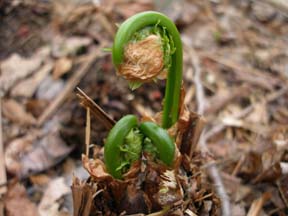
How to Prepare and Preserve Fiddleheads
by Kate McCarty, UMaine Extension Food Systems Professional, University of Maine Cooperative Extension
May means fiddlehead season in Maine, and many Mainers are excited to prepare and preserve fiddleheads—the coiled frond of the edible ostrich fern. These spring delicacies have a vegetal flavor, often compared to asparagus, and are harvested wild in the Maine woods. Fiddleheads can be prepared and preserved in the freezer or pickled and canned for year-round enjoyment.
Identifying Fiddleheads
First, you’ve got to know what you are looking for. Proper identification of the fiddlehead fern is very important, as not all ferns are edible, and some are even carcinogenic. Look for a smooth (not fuzzy), U-shaped stem with a brown papery coating on the ostrich fern fiddlehead.

For more information on properly identifying and harvesting fiddlehead ferns, watch UMaine Extension Agricultural Professional Dave Fuller’s video on Identifying and Harvesting Fiddleheads. Dave’s got great information on how to spot fiddleheads and how to harvest them sustainably so more will grow next year.
Preserving Fiddleheads
Because fiddlehead season is so short, many people are interested in learning how to prepare and preserve fiddleheads to enjoy all year long. Fiddleheads freeze well and can be pickled and canned using a boiling water bath canner. There are food safety concerns with eating fiddleheads—the Center for Disease Control and Prevention (CDC) reports several cases of food-borne illness associated with improperly prepared fiddleheads. To safely prepare fiddleheads, wash well and cook fiddleheads thoroughly before eating (boil them for at least 15 minutes or steam for 10—12 minutes).
Freezing Fiddleheads
To freeze fiddleheads, blanch in boiling water for 2 minutes and then plunge into an ice bath to stop the cooking. Drain them well and pack into a labeled freezer-grade container. When it’s time to serve your frozen fiddleheads, you’ll still need to boil them for at least 15 minutes or steam for 10—12 minutes to reduce the risk of foodborne illness. More detailed instructions for freezing fiddleheads are available in our publication, Facts on Fiddleheads.
Canning Fiddleheads
If you are interested in canning fiddleheads, several research-based recipes are available. We do not recommend canning fiddleheads in a pressure canner, because process times have not been established and tested for home food preservation. Instead, pickled fiddleheads can be canned in a boiling water bath canner. We have five recipes for different types of fiddlehead pickle recipes from Bread and Butter to Garlic Dil in our publication Facts on Fiddleheads—try several recipes and see which is your favorite. To learn more about proper canning methods, explore our Food Preservation resources.
Using Fiddleheads
Once you’ve frozen or pickled fiddleheads, you can use them in recipes like Shrimp and Fiddlehead Medley or Fiddlehead Dijon. Both can be found in our publication Facts on Fiddleheads. Remember to thoroughly cook frozen fiddleheads by boiling them for at least 15 minutes or steaming them for 10—12 minutes before serving. With these safety tips in mind, you can enjoy these unique spring delights all year long. Happy foraging!
